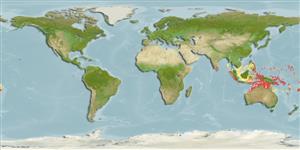>
Perciformes/Serranoidei (Groupers) >
Liopropomatidae (Painted basslets) > Liopropomatinae
Etymology: Liopropoma: Greek, leio = smooth + Greek, pro = in front of + Greek, poma, -atos = cover, operculum (Ref. 45335).
More on authors: Randall & Taylor.
Environment: milieu / climate zone / depth range / distribution range
Ekologi
laut berasosiasi dengan karang; kisaran kedalaman 18 - 50 m (Ref. 48635). Tropical; 15°N - 20°S
Western Pacific: Philippines, Palau, Papua New Guinea, the Solomons, Fiji, and Osprey Reef in the Coral Sea; also in Rowley Shoals in the eastern Indian Ocean.
Size / Weight / umur
Maturity: Lm ? range ? - ? cm
Max length : 8.0 cm TL jantan/; (Ref. 2334)
Duri punggung (Keseluruhan (total)) : 8; duri punggung lunak (Keseluruhan (total)) : 11 - 12; Duri dubur: 3; Sirip dubur lunak: 8. Easily identified by the unusual coloration. The yellow is obvious but the red looks grey when seen in natural light (Ref. 48635). Differs from L. tonstrinum by having numerous red pinstripes on its sides, a less pronounced white lateral stripe, and a serrate posterior preopercular margin (Ref. 37816).
A benthic species (Ref. 75154), generally taken from caves (Ref. 1602) with rotenone used for collection (Ref. 1602). Also a ledge dweller and secretive (Ref 90102).
Life cycle and mating behavior
Kematangan | Reproduksi, perkembang biakan | Pemijahan | telur-telur | Fecundity | Larva
Myers, R.F., 1991. Micronesian reef fishes. Second Ed. Coral Graphics, Barrigada, Guam. 298 p. (Ref. 1602)
Status IUCN Red List (Ref. 130435: Version 2024-1)
ancaman kepada manusia
Harmless
penggunaan manusia
Alat, peralatan
laporan khas
muat turun XML
Sumber internet
Estimates based on models
Preferred temperature (Ref.
123201): 26.2 - 28.5, mean 27.2 °C (based on 56 cells).
Phylogenetic diversity index (Ref.
82804): PD
50 = 0.5000 [Uniqueness, from 0.5 = low to 2.0 = high].
Bayesian length-weight: a=0.00389 (0.00180 - 0.00842), b=3.12 (2.94 - 3.30), in cm total length, based on all LWR estimates for this body shape (Ref.
93245).
Trophic level (Ref.
69278): 3.6 ±0.6 se; based on size and trophs of closest relatives
Fishing Vulnerability (Ref.
59153): Low vulnerability (10 of 100).
